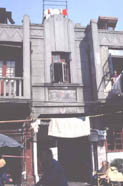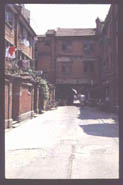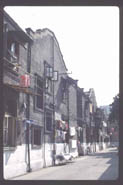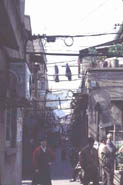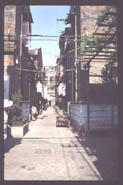6.1 Lilong as an urban form
6.1.1. THREE URBAN DESIGN THEORIES
To clarify the generic pattern of lilong housing and to explore its urban characteristics, three urban design theory could be utilized: (1) figure-ground theory; (2) linkage theory; and (3) place theory.(29) These theories differ significantly from each other, but taken together can provide with comprehensive understanding of integrated spatial design of a built environment.
I). The Figure-ground Theory
Roger illustrated in his book, that, The figure-ground theory is founded on the study of the relative land coverage of buildings as solid mass (figure) to open voids (ground)... Each urban environment has an existing pattern of solids and voids, and the figure-ground approach to spatial design is an attempt to clarify the structure of urban spaces and the generic patterns of mass and voids in a city or district... He also added that, The figure-ground drawing, a two-dimensional abstraction in plan view, is a graphic tool in revealing these relationship (p.97).
II). The Linkage Theory
Roger explained about Linkage Theory: Unlike the figure-ground theory, which is primarily based on patterns of solid and void, the linkage theory tries to organize a system of connections, or a network, that establishes a structure for ordering spaces (p.97). These linking elements can be streets, pedestrian ways, and linear open space, etc., that physically connect the parts of a city. It places emphasis on the circulation diagram rather than the spatial diagram of the figure-ground theory.
III). The Place Theory
The place theory goes one step beyond figure-ground and linkage theories in that it adds the components of human needs and cultural, historical and natural contexts (Roger, 1986, p.98). It gives physical space additional richness by incorporating unique forms and details indigenous to its setting. In place theory social and cultural values, visual perceptions of users, and an individual control over the immediate public environment are important principles.
Each of these approaches has its own values, but are interrelated. Combining the three, it can give a comprehensive evaluation on various facets of a particular structures within a built environment - the mass-void relationship, organization pattern, and its sensitivity to human needs.
6.1.2. SPATIAL FEATURES - STUDYING LILONGS IN THE FIGURE-GROUND THEORY:
Reviewing the general plan of a lilong settlement, it can be seen that the building coverage is denser than the open space, thereby giving shape to the public opening - in other words, creating positive voids, or "space-as-object".(30) The open space in a lilong settlement has a well-defined shape. They seems to be carved out of the building mass as a continuous flow linking interior and exterior spaces. Without the critical coverage of housing mass, this spatial continuity would be impossible. Void here is conceived as a positive entity in an integrated relationship with surrounding solids. The void space are the vessel containing human beings social activities, represent the tension between the individual and the collective. They also represent transitions between the public and the private, and arenas for discourse and interaction. A predominant field of solid (mass housing) and voids (open space) created in this way are often called as urban fabric (Roger, 1986, p.99). This relationship of solids to voids can reveal the generic spatial pattern of a lilong settlement.
To further clarify the spatial pattern of lilong settlements, several types of solids and voids have to be examined. The solids in lilongs is formed by a mixed pattern of mass determined by their usage, in which commercial mass take the street front and residential mass occupy the internal urban block, with appropriate spacing, bulk and vertical dimension. A repetition and a predominant field of this mass pattern establish a continuous urban fabric, setting up a vocabulary that governs building volumes and facade styles in old districts of the city.
Like urban solids, there are certain definable urban voids. 1). The first is the entry foyer space that establishes the important transition from common territory to semi-public domain. Security surveillance by the randomly dispersed small business or vendors, and the fact of residents peering out their windows forming "eyes on the street", are significant social consideration of the entry. The entry space is also a semi-public gateway visible to a selected few from the streets and announcing the arrival of individuals to their own space (Roger, 1986, p.99). 2). A second type of voids is the primary network of lanes and squares, a category that corresponds to the predominant field of building mass and that contains the active semi-public life of the settlement (Roger, 1986, p.103). As extensions of the home and places for discourse among neighbors, they formed a systematic hierarchy of order from citywide routes to locally controlled space for communication. They are places to be - to spend time in as well as corridors through which to move.
By using figure-ground theory, we can identify the basic spatial pattern of a lilong settlement is its clear-structured mass-void relationship and finely integrated urban fabric. We can also comprehend the functional meanings of voids which are usually found vague in contemporary urban development. In lilongs, mass and voids are structured more in balance, hence they coexist effectively. With the large land coverage of housing mass, space left out are still enjoyable and meaningful. Lilongs, in low-rise pattern, achieved land-use efficiency by optimizing the use of every inch of space.
Contrary to lilong settlements, recent housing estates, where the buildings are more figural, or as free-standing objects, produce unconfined voids. The relationship of solids to voids is poorly balanced, fragments became disjointed. Urban space is frequently interrupted or weakened and sometimes lost. As in the "Tower in the Park" concept, the attempts to place vertical elements over a large ground plane result in vast open spaces difficult to maintain or control and hence seldom used or enjoyed (Schoenauer, 1994, p.117).
6.1.3. ORGANIZATION PATTERN- STUDYING LILONGS IN THE LINKAGE THEORY:
In linkage theory point of view, the basic linking elements in lilong settlements are their networks of main lanes and side lanes. They form the circulation and primary organization structure of this settlement. A basic house form resolving upon the linking elements generates the settlement from. The individual house can be added or subtracted from the linking elements without changing the settlement form of a lilong.
The main lanes are usually placed in the center or busy location of a site, with their intersection with commercial streets as entrances of a lilong. They are usually 6m wide at least, allowing vehicles and bicycles to pass. Varying in numbers, they form the first level of circulation network, introducing the public space of a city into the semi-public space of a settlement.
The side lanes are to link the main lane to the entry gate of each dwelling unit. There are several types of side lanes - one connects the main lanes on both ends; the second one connects the main lane on one end, while the other end remains as a cul-de-sac; and the third one connects the main lane on one end, while the other end is left open to a commercial street. The side lanes, as pedestrians, are usually 2.5m wide at least, however some are only 1.5m. Since many families tend to use their back entrances to access their houses, or to remove part of their housework from kitchens to side lanes, the function of side lanes are getting complicated. The side lanes are the secondary level of circulation network connecting the semi-public space of the settlement to the private domain of dwelling activities. They also function as the semi-private open space of the settlement. The linking pattern of side lanes with main lanes can be in T- or Cross-shaped, with some in a more organic pattern.
The hierarchical order of organization network from public to semi-public, to semi-private, and to private, can not only maintain a circulation efficiency on main lanes, but also ensure the children' safety, and protect the intimacy of dwelling life on side lanes. This hierarchical pattern of circulation network decreases the disturbance of trespass traffic, and help to establish a sense of order, or unit identity (e.g. unit number), for all houses within the settlement. The cul-de-sac pattern of linking elements are advantageous to safety, control, self-management by residents, thus a tranquil environment for dwelling activities can be achieved within the bustling location of commercial area.
The study of linkage element of lilong settlements is important to the understanding of their urban structure.
6.1.4. THE SENSE OF PLACE - STUDYING LILONGS IN THE PLACE THEORY:
In abstract, space is a purposeful void with the potential of physical contents. It only becomes a place when it is given a contextual meaning derived from cultural or regional background (Roger, 1986, p.112). While types of space can be defined by categories or typologies based on physical properties, each place is unique, taking on the character of its history and surroundings. A place is a space which has a distinct character, and a stable system in which people can develop their social, cultural and political values and behaviors (Roger, 1986, p.113).
In order to give space an emotional content - a presence that is more than physical, some aspects need to be taken into account in spatial design: the local history, the feelings and needs of the populace, the tradition of craftsmanship and indigenous materials, and the political and economic realities of the community.
The good things about lilong housing is that it has many attributes which are devoted to the creation of meaningful places, hence their residents are very proud to call it as home.
The spatial enclosures of the settlement form, clear boundary formed by streetfronts, unique form of entry gateway, and a gradual spatial declaration from the public space of the city to a semi-public space for residence, demonstrate a strong presence of a community. The definable urban edge, or boundary is, as Martin Heidegger had described, "not that at which something stops, but that from which something begins its presenting". The unifying architectural characteristics which derived from a repetition of a single or several of house models, increases lilongs' environmental identity and unifying character. Each lilong, as a spatial and social unit, has its own distinctiveness.
Local vitality based on a mixed pattern of urban land-use, and small business or vendors springing up in and around the settlement, activates residents' lives. Safety, control, local administration and small scaled community activities, enriches social, cultural and political contents of the physical space.
Possibility for personalization allows residents to experience and exert control over their immediate outdoor space. The inherited humane scale, usable open space for each family, and safe ground for children and elderly, all add up to the feeling of being at home. Traditional ornamentation, craftsmanship and local materials depict the history of locale and deliver the continuity of time.
[ TopOfPage(); ]
6.2. Lilong as a community
6.2.1. FOUR COMMUNITY DESIGN PRINCIPLES
The study of lilong housing is not about an individual house form, or groups of houses. It is about a pattern of urban form in which a complex interplay of physical, social, economic and political forces had come to form and shape the places. The physical form of this settlement shelters a community in association with its self-administrated organization, social structures and economical services. In order to address the comprehensive design issues involved in generation of this urban form, or to examine the livability of the settlement environment, one must first consider the interaction between two essential components of community - the physical environment and the user. Only by adopting an interdisciplinary system in evaluation and by examining both components, can we achieve a comprehensive understanding of the functional, environmental and psychological living qualities within the built structure of the settlement.
Reviewing prominent urban design theories in recent years, the "Four Principles of Community Design"(31)
by Sherwin Greene has encompass the broad range of design considerations involved in evaluating the quality of places and the quality of living. They represent distinct and vital attributes, significant enough to have universal application to all environment, and broad and flexible enough to be utilized and explored in any given condition(Sherwin, 1992, P.180). Following is a brief outline of the four concerned principles associated with its corresponding qualities or sub-criteria.
FUNCTION requires that the design work effectively for the convenience and comfort of all its users.
1). Linkage
2). Security
3). Comfort
4). Diversity
ORDER assures that users can become oriented to the environment and understand it.
1). Coherence
2). Clarity
3). Continuity
4). Balance
IDENTITY denotes a visual image of the environment that reflects special or unique qualities.
1). Focus
2). Unity
3). Character
4). Specialness
APPEAL characterizes a design that gives pleasure to its users over time.
1). Scale
2). Appropriateness
3). Vitality
4). Harmony
The above Four Principles will be used as a reference in the following illustration, in which the author will elaborate the major concerned features that have made lilong settlements a meaningful place. Some drawbacks observed in lilongs will also be elaborated at the same time.
The principle and qualities involved in community or urban form design are broad, the number and type of lilong settlements are numerous. It is hard to cover the broad range of issues or to conduct a generalized assumption to all lilongs, whose qualities may vary one from another. An accurate evaluation will have to build on more accurate and profound information. Hence the following analysis can only be used as a reference, or viewed as experience drawn on from the cases that the author had surveyed.
6.2.2. THE QUALITY OF LIVING IN LILONG SETTLEMENTS
Linkage
The linkage of a lilong to its urban setting is established by its entrances. An entrance is usually set among its commercial units at streetfront, taking on the space of one unit in the plan. The entrances are the only horizontal connection the lilong settlement has with its urban surrounding, and through which the internal society can communicate with the rest of the city (Fig. 6.2.2a).

The idea of using the entrances as the exclusive linking element from lilong settlement to its urban setting has three basic functions. 1).The simple architectural articulation of entrance intends to maintain the spatial continuity of streetscape. It is interesting that streetshoppers may sometimes even unable to notice the entry way is an access towards a residential community. 2). The economic land occupancy of entrances also intends to save urban land. It is observed that all the streetfront urban space is taken by shops, stores and other commercial activities. Even the entry way is sometimes partially filled up with small-scale businesses. 3). The limited number of entrances is advantageous for safety control over the internal environment, and to maintain administration towards all the passers-by.
Security
The limited entrances, the efficient use of open space and lanes, and residents' self control over their immediate environment, have combined to establish a hierarchical surveillance system which assure the community strong sense of security (Fig. 6.2.2b). This character is more apparent in Shi-ku-men type of lilongs, where neighbors have higher socially responsible attitude, and spaces were conceived in more intimate scale.
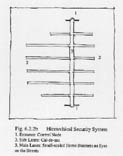
Throughout the built environment, there is rarely a patch of no-man's land. Every space is conceived positively or in an economic sense. The space in a side lane is kept in very intimate scale, 2 ~ 4m wide, allowing 2 ~ 3 person to pass at one time, and most side lanes are cul-de-sacs. Even though when no residents is out in open area to watch, strangers still can't escape the eyes from indoors. People sharing one side lane is like a big-family. They care for each others. After all, the small shops or home-base businesses scattered around the public domain are voluntarily in watching of passer-by in the main lanes. This amenity is especially beneficial to children (Fig. 6.2.2c).

Comfort
Once stepped inside the entrance of a lilong, one will be impressed by the sharp contrast of internal peace with external turbulence. This physical ease fostered in lilongs is mainly attributed to the continuous shops at streetfronts acting as a spatial acoustic buffer that blocks out the street noise. Though located in busy district, and surrounded by traffic and commercial activities, the internal residential spaces are set free from the exterior urban noise. The daily living zones of dwelling units are further protected from noise generated in main lanes by high gabled-walls featured in corner buildings of every housing row (Fig. 6.2.2d).

The hierarchical spatial sequence of circulation network assure a sense of order to the internal environment, as different dwelling activities are distributed at different levels.
Functional comfort was generally achieved in the New-type, Garden and Apartment type of lilongs. Their housing units usually have upper or high standard interior facilities and finishes, such as several of bathrooms, separate kitchen and dinning-room, a library, gas & electricity (utilities), marble or wooden flooring (finish), and even a garage and a fireplace. However, the Shi-ku-men type of lilong didn't even have basic sanitary facility - the bathroom, and most kitchens didn't use gas.
Visual comforts was also better achieved in the New-type , Garden or Apartment type of lilongs. There are two successful examples in forming pleasing places by skillful integration of greenery with architecture. One is Chang-le Village - a New-type lilong (Case 4.4), where beautifully landscaped open gardens create a delightful scenery and embellishes the white walls, red tiles of the traditional architecture. The other one is Shan-nan Village - an Apartment lilong (Case 4.9), where the dense woods in organic and vibrant layouts has set off the solid structures and concealed their big scale. It also creates ever-changing vista along the meandering lanes. Garden lilongs often have generous greenery space and beautifully landscaped gardens to achieve visual sense of vitality (Case 4.8 & 4.11).
On the contrary, the Shi-ku-men type of lilong generally has a very compact space. Therefore they have to rely on innovative articulation of greenery to create visual asset. As in the case of Tong-fu Li (Case 4.3), vivacious vines and plants, sprawling along the gabled walls or growing on the wooden frames, has generated a delightful natural green pavilion in the main lane, under which groups of children and elderly love to stay (Fig. 6.2.2e).
However, the quality of comforts and visual ease is not well achieved in some lilong settlements, especially the earlier-built Shi-ku-men lilongs due to a shortage of space and a lower standard condition (Case 4.1). Some have suffered from extremely narrow lanes, small unit space, lacking of communal greenery. Due to these factors, comforts had failed to be achieved in the built environment. However, even though it is hard to find a well-defined greenery space in common area of a Shi-ku-men lilong, it is not hard to discover many mini scale of visual pleasure or delight of green in the courtyards, on windows, and balconies, created by their dwellers.
To summarize, though the level of physical comforts might vary in different lilongs, the emotional sense of tranquillity and order cultivated in the build environment is a common achievement to all lilongs, no matter old and new.
Diversity
Dwelling activities are based on two environments. One is physical environment, consisting of physical form, building type and structures; the other one, is social environment, comprising amiable atmosphere of community, relationship between neighbors, shopping conditions, education & health-care facilitates, and public service convenience, etc.(Bao, 1992, p.59). The first one may contains the "standard of living", but the second one represent the "quality of living", which is more fundamentally appreciated and increasingly pursued by modern dwellers.
Chinese people living in the city habitually go to food market early morning. For them, they have to first purchase daily food necessity such as meat, vegetables and fruits before going to work. They also have to purchase breakfast on their way back home. The morning in Shanghai is vibrant and busy, often referred as "battling morning". It is a common phenomenon that people rush to work while eating their breakfast. Hence the shopping conditions must be made favorable to them in a good settlement.
Preschool education and health-care is another consideration for families. Kindergartens, elementary schools and hospitals should be a short distance away, or easily accessible, since parents normally have to send their kids to kindergartens or schools on their way to work. The mixed pattern of social program and facilities can bring along more daily convenience to dwellers.
In this respect, lilongs' mixed pattern of dwelling forms creates high degree of social diversity to urban mechanism and have made the urban living convenient, dynamic and pleasurable. Morning shopping can be undertaken in food market in proximity. Breakfast can be bought from refreshment stores at adjacent alleys or streets. This life convenience contrast to the scarcity of choice in mono-residential districts dominated by concrete-slab prefabricated high-rise buildings, built in late 70s or 80s.
There are many elementary and secondary schools in downtown area, so preliminary education can be easily pursued in adjacent areas of lilongs. Teachers also prefer to stay in economic and socially dynamic districts. Hospitals is within convenient accessible range, or it will be economically more affordable by taking a cab to get to hospitals should an emergency occur.
Downtown Shanghai offers the most dynamic night life in the world, where shopping, theaters, and night bars have woven a vivid and colorful pictures of urban amusement. Even today, window-shopping along major commercial streets (e.g. Nanjing Road, & Huai-hai Road) has been taken as a modern type of pleasure, especially enjoyed by young. To enrich people's life, municipality of Shanghai recently stipulated that the major commercial streets in downtown such as Nanjing Road and Huai-hai Road be opened as pedestrian walkway exclusively after 6:00 pm on weekends. This is another thing favorable to residents of Old Residential District (ORD), since they are all close to these prosperous streets. This pleasurable and delightful amenity available for people to enjoy today is something that had deeply rooted in the initial urban land-use patterns, application of settlement forms, scales, intensity and their relationship with streets. Not doubtful, the integration of living and commercial activities within one urban block, and the disposition of human-scaled commercial streets have contributed to generation of the excitement and charming character of the old residential districts.
The broadest possible mix of residential, commercial, social and cultural variety, promotes city vitality. The street-life created by the built structures is something that can make a city identifiable and exciting. Jane Jacob has commented that: "City streets must constantly be active and controlled by people who live, work, and relate to them in housing and employment buildings."(32)
For her, the hustle and bustle of crowded sidewalk life in the corridor streets generates the excitement, interaction, and beauty that form the essence of what makes central areas of great cities around the world so appealing.
Lilong is a mutually-supportive and socially and vice versa controllable pattern of urban form. Prosperity in commercial streets enrich residents' life. Populace of residential area in the old city form the strength that can assure safe walking in downtown streets. Space behind commercial units can be used as workplace or storage. Extra heat and electricity generated in large shopping stores can be utilized for residential use over nights. Home business in lilongs facilitate convenience of daily living and create opportunity for self-employment. Social organization and public service within the settlement provide residents especially the elderly an chance to exert their energy and enthusiasm. Children and the old, spending time together, have established an understanding and mutually supportive relationship when working parents are out. Within the built structure, "functional integration is matched by a degree of social integration." As Kevin Lynch has stated, this quality is "surely a legitimate feature of good settlements, within which one can organize politically when the need for control arises. ... For certain age groups, particularly the young and old, a place-based social community is quite important in maintaining self-protection and self-consciousness (Lynch, 1981, p.248-249).
In short, this type of settlement, decreases the noise and danger of fast traffic, and increases the possibility of local organization and control, all without major cost (Lynch, 1981, p.248). Apart from that, the fact of being in an identifiable settlement which has quiet, safe internal lanes, easily accessible daily services and vital street-life in close proximity, has make the living so pleasurable. Everyone is aware of the diversity around him or her, and is in visual contact with other ways of life (Lynch, 1981, p.303).
Clarity
Clarity is, in a small place the sense of how its parts fit together, and in a large settlement the sense of orientation (Lynch, 1981, p.134).
Applying to all lilongs, a clear sense of entrance and closure, and hierarchical spatial structure, make the settlement more comprehensible and improve its response to the quality of clarity (Fig. 6.2.2f).
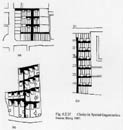
All side lanes stem orthogonally from main lanes, or parallel to urban streets. This help the residents, even the new comers, to be easily oriented in the internal environment of lilong settlements. Buildings are generally north-south orientated.
The dramatic visual rhythm formed by a repetition of buildings, their court-yards and entry gates, convey the sense of continuity and emphasize the principle of order.
Balance
The urban space of lilongs is conceived horizontally rather than vertically, having large land coverage. Its solids (building mass) consisting of primarily low-rise buildings, spatially define a series of intimate scale urban voids (internal open space). The shape of space carved out of the mass are clear and identifiable, hence appropriate usage in them can be assumed. This relationship between the dominated mass coverage and positive use of open space help to establish a sense of spatial balance within the built structure.
The predominate coverage of low-rise housing development in central city generates a fine-grain pattern of urban fabric, differing from a rather rough-grain pattern of urban fabric in the city outskirts.
Identity
"Identity is the extent to which a person can recognize or recall a place as being distinct from other places - as having a vivid, or unique, or at least a particular, character of its own (Lynch, 1981, p.131)."
Lilong settlements were usually built by small developers using traditional construction methods. Unlike contemporary prefabricated housing developments constructed in the city outskirts of Shanghai where mono character dominates the urban fabric, the lilong settlements usually have more individuality and specialty. The variety of lilong types bestowed architectural richness to the physical form of lilongs. The unifying character of a settlement derived from repetition of its basic components and order strengthened the settlement's identity and the sense of a place.
Focus
A focal point as a place of assembly, or social intercourse, is very important in community design. It is noticed that a fixed object acts as a magnet to movable objects(Gordon, 1961, p.103). In the case of human settlements, meaningful or functional fixed elements can attract the most movable objects - human beings. A tree provides shade and shelter; a bench allows people to sit; a shop solicits people to linger; and a newspaper-board attracts people to stay and read. People themselves, for different reasons, also need anchorage in their various outdoor activities of trade, recreation and social life. Hence lands of greenery, pieces of sitting area, groups of shops, and nodes of public service, turn the dissociated stream of people into groups, and become identifiable rallying points. These features have all been skillfully integrated in most of lilongs (Fig. 6.2.2g).

Scale
Appeal is an intuitive human feeling response to aesthetic appreciation of objects. Whilst cultural factors will have a profound influence upon the manifestation of aesthetic perception, the fundamental mechanisms seem to be universal which had transcend time and culture. It (appeal) may deal with pattern of rhythm, state of balance, degree of harmony, and sensitivity of scales, etc., - to include all, the pleasure of sensation, especially the visual, authentic and emotional pleasure received in the process of experiencing the objects.
Scale is also an attribute of the "Appeal". Human scale can make a space inviting and friendly and thus arouse a person intense sense of familiarity and comfort while walking through it. The amiable atmosphere attained in side lanes of lilongs adds to the friendly feeling of the places. Given the sub-tropical condition of the region, the city is hot in summer and cold in winter. The appropriate building distance arrangement assures sufficient sunshine in the ground-floor rooms, but also maintains a large portion of shady area in side lanes. Hence in summer, the direct radiation into side lanes only lasts for two hours at noon. The busy social life lead by residents at mornings and afternoons won't be effected by the hot sun, and many people have taken it as the best place to enjoy the cool. The side lanes are also protected from wind flow in sever winter. The nice micro-climatic environment ensures frequent use of side lanes, forming a vivid and charming scene of dwelling activities of the most ordinary people (Fig. 6.2.2h).

Attributes of appeal is hard to be briefly concluded here. True qualities of an aesthetic place can only be comprehend when all circumstance of a project are given. Generally speaking, for lilong settlement as a whole, their sense of order and rhythm, quality of harmony and conformity, and intimate-scale streetscape, are part of the elements that make lilong' space appealing.
[ TopOfPage(); ]
6.3. Lilong housing as an embodiment of dwelling culture
There is one factor that the author wants to specifically point out as a more fundamental and essential point to understand of the life in lilong. The cultural and behavioral habits of a nation, or a certain region, has played an important role in the way of using their shelters.
Lilong housing was firstly introduced from Western row housing. It bears many similar characteristics such as aligning in rows, and many similar advantages such as cost-efficiency in terms of economic use of infrastructure and initial site development expense, or energy-efficiency by sharing the common walls. However, differed significantly from row housing, lilong settlements had created an unique type of atmosphere which is indigenous to Chinese dwelling culture and behavior - a frequent and strong social interaction allowed by the built form. Chinese people have long developed an ethic habit and behavior in their dwelling activities. People like to spend time together. They consider social activities and neighborly interaction to be pleasurable experience or fun. They like to eat together (making dumpling), playing games ("ma-jiang" or "poker") in a group, sitting around to chat, or talking about legendary stories ("long-men-zhen") in courtyards, etc.
Lilong housing has taken into account the cultural background of Chinese dwelling and integrated the concerned issues in the process of design. By allocating at least one courtyard and a portion of usable open space for each family, and by allowing a spatial fluidity through them, the daily communication can be conducted while doing housework, and socializing pleasure can take place in an elastic way in the courtyard, in the lanes, and enjoyed by all (Fig. 6.3).
Fig. 6.3: The Lanes on Sunday (currently unavailable)
Living so close to each other, sharing experience and amusement every day, the families inside the lilong become one big family. Strong sense of belongings, social esteem are aroused in the built structure and grow in every day life. The local residence's committee, comprised of warm-hearted senior citizens, represent the local political power, under whose leadership, the whole community make efforts to construct a pleasant and civilized living environment.
As Amos Rapoport (1969, p.28) has elaborated, "The house is an institution, not just a structure, created for a complex set of purposes. Because building a house is a cultural phenomenon, its form and organization are greatly influenced by the cultural milieu to which it belongs. ... if provision of shelter is the passive function of the house, then its positive purpose is the creation of an environment best suited to the way of life of people - in other words, a social and cultural unit of space."
The idea of a settlement as a social control mechanism, so strong in traditional cultures at least, may no longer apply with as much force in a society with the formalized and institutionalized control systems of today...... The link between culture and form is weakened due to the fast development of technology and widely application of them without particular concerns to a given context ...... As a result, housing forms and patterns are internationalized, neglecting the local culture that have accumulated indigenous customs and habits. (Rapoport, 1969, p.22-44)
Only by understanding that houses or settlements are not only physical containers of a group of dwellers but also psychological embodiments of dwelling activities, dweller's culture and religious belief, etc., which are more fundamentally rooted in life than the architectural forms, can humane and appealing residential environment be constructed. The designers of Lilong projects understood this very well.
[ TopOfPage(); ]
29. 29 Reference: Roger Trancik, Finding Lost Space - Theories of Urban Design, 1986, Chapter IV, p97-124.
30. 30 A term used in Finding Lost Space, p98.
31. 31 Reference: Sherwin Greene, Cityshape: Communicating And Evaluating Community Design, APA Journal 179, p.179-185, 1992.
32. 32 Source: David R. Hill, Jane Jacob's Ideas on Big, Diverse Cities, - a Review & Commentary.
[ TopOfPage(); ]
